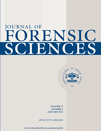The Effect of Body Coverings on the Formation of Adipocere in an Aqueous Environment
Abstract
Abstract: Adipocere is a postmortem decomposition product that consists of a mixture of fatty acids. The rate of formation of adipocere from pig adipose tissue in an aqueous environment has been monitored. The effect of various clothing and carpet material types on the process was investigated. The fatty acid composition of the adipocere was determined at regular intervals using gas chromatography–mass spectrometry. Examination of the changes to fatty acid concentrations allowed the degree of adipocere formation in the different environments to be estimated. The study demonstrated that the rate at which adipocere forms is particularly accelerated by the presence of coverings produced from natural materials. Elemental analysis by inductively coupled plasma–mass spectrometry revealed, for the most part, little change to the cations present in the adipocere formed. However, an increase in Ca concentration was observed for tissue wrapped in acrylic carpet, which was associated with a CaCO3 additive used in the carpet manufacture.




